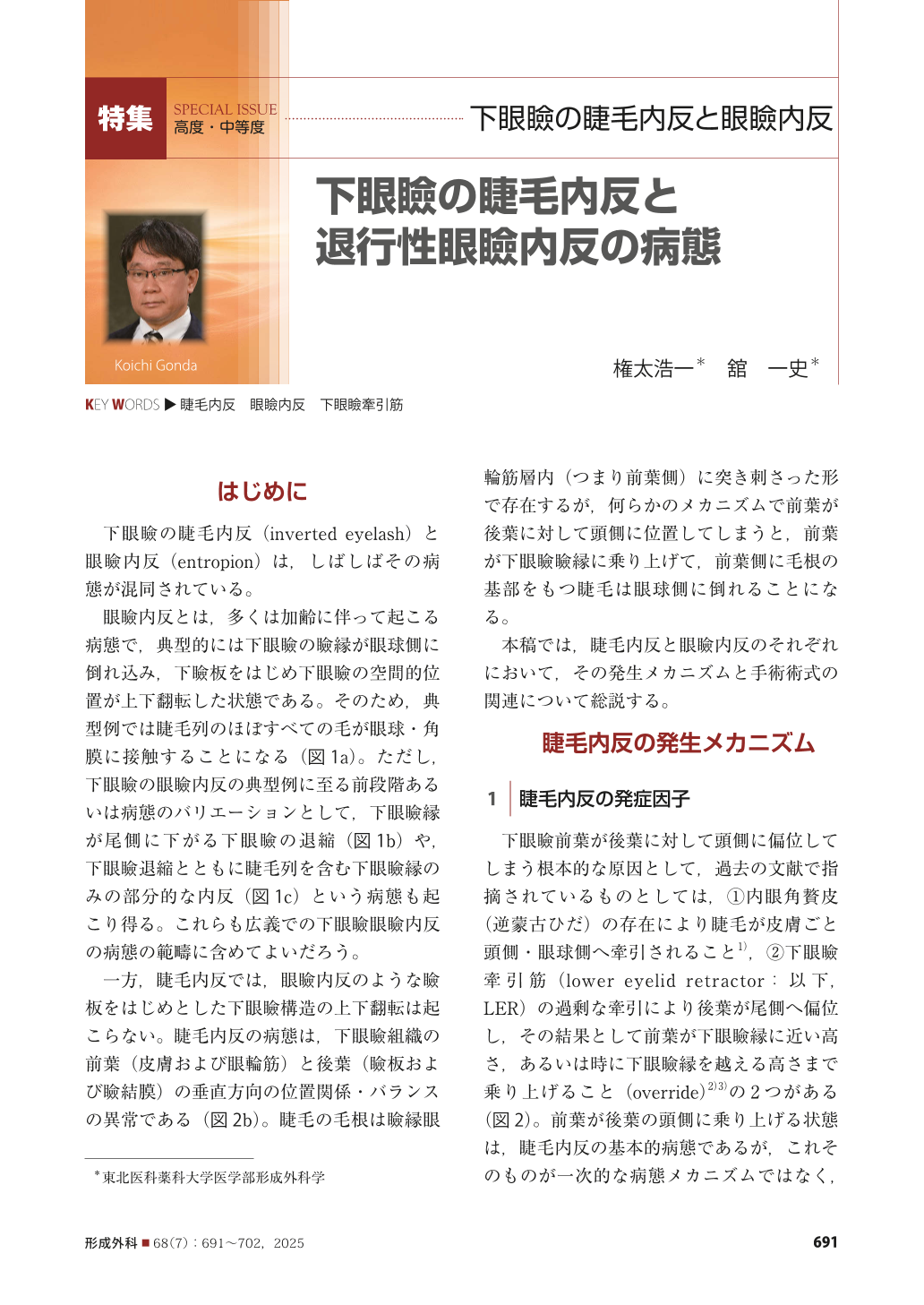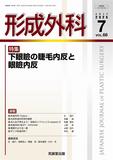Japanese
English
- 有料閲覧
- Abstract 文献概要
- 1ページ目 Look Inside
- 参考文献 Reference
はじめに
下眼瞼の睫毛内反(inverted eyelash)と眼瞼内反(entropion)は,しばしばその病態が混同されている。
眼瞼内反とは,多くは加齢に伴って起こる病態で,典型的には下眼瞼の瞼縁が眼球側に倒れ込み,下瞼板をはじめ下眼瞼の空間的位置が上下翻転した状態である。そのため,典型例では睫毛列のほぼすべての毛が眼球・角膜に接触することになる(図1a)。ただし,下眼瞼の眼瞼内反の典型例に至る前段階あるいは病態のバリエーションとして,下眼瞼縁が尾側に下がる下眼瞼の退縮(図1b)や,下眼瞼退縮とともに睫毛列を含む下眼瞼縁のみの部分的な内反(図1c)という病態も起こり得る。これらも広義での下眼瞼眼瞼内反の病態の範疇に含めてよいだろう。
一方,睫毛内反では,眼瞼内反のような瞼板をはじめとした下眼瞼構造の上下翻転は起こらない。睫毛内反の病態は,下眼瞼組織の前葉(皮膚および眼輪筋)と後葉(瞼板および瞼結膜)の垂直方向の位置関係・バランスの異常である(図2b)。睫毛の毛根は瞼縁眼輪筋層内(つまり前葉側)に突き刺さった形で存在するが,何らかのメカニズムで前葉が後葉に対して頭側に位置してしまうと,前葉が下眼瞼瞼縁に乗り上げて,前葉側に毛根の基部をもつ睫毛は眼球側に倒れることになる。
本稿では,睫毛内反と眼瞼内反のそれぞれにおいて,その発生メカニズムと手術術式の関連について総説する。
The pathophysiology of an inverted eyelash of the lower eyelid involves excessive traction of the posterior lamina by lower eyelid retractors (LERs), resulting in a caudal displacement of the posterior lamina and an override of the anterior lamina (skin and orbicularis oculi muscle) over the lower eyelid margin. This phenomenon, along with the presence of epicanthus (i.e., an inverted Mongolian fold) causes the eyelashes to fall towards the eyeball. Involutional entropion of the lower eyelid is due mainly to aging, which causes tissue relaxation of the lower eyelid in both the vertical and horizontal directions. In addition, an imbalance in which the relaxation of the upper edge (grey line) is less than that of the lower edge of the tarsal plate — along with the maintained tone of the orbicularis oculi muscle pressing the entire lower eyelid towards the eyeball — results in the flip and inversion of the lower eyelid tarsal plate towards the eyeball.
The options for the correction of a lower eyelid inverted eyelash include symptomatic treatments such as the Hotz procedure, which generates scar tissue parallel to the eyelid margin. More radical procedures that directly address the pathophysiology, e.g., disconnecting the excessively pulling LERs or correcting the epicanthus, are considered more effective. For the correction of involutional entropion of the lower eyelid, the Jones procedure and LER advancement, which address vertical laxity, as well as partial resection and plication of the lower eyelid tissues or the lateral tarsal strip procedure, which address horizontal laxity, are indicated. Notably, procedures such as rhomboid excision and horizontal plication of lower eyelid tissues (which also correct the imbalance in laxity between the upper and lower edges of the tarsal plate) could be more effective. Correcting both horizontal laxity and vertical laxity is expected to minimize the likelihood of the recurrence of entropion.

Copyright© 2025 KOKUSEIDO CO., LTD. All Rights Reserved.


